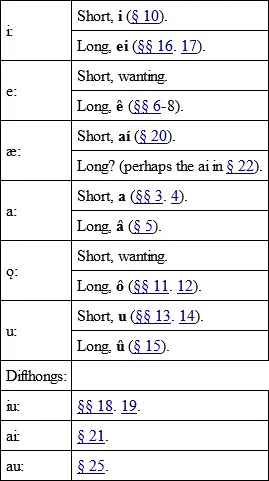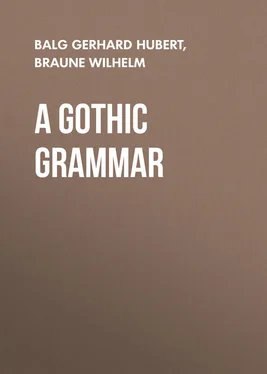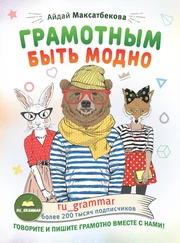§ 27. Beside the vowel-signs discust in the foregoing paragrafs, a few consonant-signs may likewise discharge the function of vowels, for the Gothic liquids l, rand the nasals m, nar very often vocalic (i. e. syllabic) at the end of a word after a consonant. Here an original suffixal vowel was lost in most cases, and in its place the following liquid or nasal became the bearer of the accent. Thus the Gothic has dissyllabic words with vocalic liquids or vocalic nasals (sonant liquids or sonant nasals); as, akrs, field ; fugls, bird ; taikns, token ; maiþms, present .
Note In the West Germanic languages a new vowel (OHG. a) has developt from these vocalic liquids and nasals; e. g., OHG. akkar, fogal, zeihhan, OS. mêþom. Cp. ahd. gr., § 65, and Brgm., I, 190. 237.
CHAP. III. TABLE OF THE GOTHIC VOWELS
§ 28. In the preceding paragrafs the Gothic vowels hav been givn according to the letters by which they ar represented. Now they wil be arranged according to the nature of their sounds, the following scale of seven vowels from i to u being taken as a basis:
i e æ a ǫ o u.
e and o denote here the close e and o (which shade very much to i and u, respectivly); æ = open e (= a in fat, fare); ǫ = open o.
In the following survey we shal state after each of these vowel grades whether it occurs in Gothic, and by what letter it is exprest.

B. HISTORICAL SYSTEM (Ablaut-Series)
§ 29. The Gothic vowels, as regarded from a historico-etymological point of view, may be groupt into a number of series of related vowels. The vowels belonging to such a series may interchange in formations with the same root; in the formation of tenses and in the verbal and nominal derivation all vowels of the same series may occur, but not such as hav nothing in common with that series. This change of vowels within a series is calld ablaut (or gradation), the series themselvs ablaut-series. The ablaut-series ar most perceptibl in the verb. The relation between the vowels of the same series is not a fonetic but a historical one; to establish it, we must pass beyond the limits of the Germanic languages and take recourse to the comparativ grammar of the Indo-Germanic languages. The Gothic ablaut-series as appearing in verbal inflection ar these (cp. § 172et seq.):
§ 30. I. Series: ei ai i (aí).
Exampls: reisan( urreisan), rais, risum, risans, to rize ; urraisjan, to raiz ; urrists, f., resurrection ; — þeihan, þaíh, þaíhum, þaíhans, to thrive ; — wait, I know ; pl. witum; weitan, to see ; weitwôds, witness ; miþ-wissei, conscience ; witubni, n., knowledge ; — lais, I know ; lubja-leisei, f., wichcraft ; lists, f. (?), stratagem ; laisjan, to teach .
Note. The iof this series is the proethnic Germanic i mentiond in § 10, b.
§ 31. II. Series: iu au u (aú).
Exampls: giuta, gaut, gutum, gutans, to pour ; gutnan, to pour (intr.); — liugan, laug, lugum, lugans, to lie ; liugnja, m., liar ; liugn, n., lie ; analaugns, hidn ; laugnjan, to deny ; — galaubjan, to believ ; galaubeins, belief ; liufs, dear ; lubô, f., luv ; lubains, f., hope ; — siuks, sick ; saúhts, f., sickness ; — driusan, to fall ; drausjan, to drop (tr.); drus, m., fall ; driusô, f., slope .
Note. The vowel ûis rare in this series; cp. lûkan, to lock ( § 173, n. 2); anabûsns(? § 15, n. 1), command , < biudan.
§ 32. III. Series: i (aí) a u (aú).
The themes of this series always hav two consonants after the vowel, mostly a liquid or a nasal in gemination, or a liquid or a nasal + another consonant. E. g.
bindan, band, bundum, bundans, to bind ; bandi, f., band ; bandja, m., prisoner ; gabinda, f., band, bond ; and-bundnan, to becum loose ; gabundi, f., bond ; — rinnan, to run ; rannjan, to cause to run ; runs, m., a run, course ; rinnô, f., brook ; — waírpan, warp, waúrpum, waúrpans, to throw ; uswaúrpa, f., a casting out or away, an outcast ; — þaírsan, to be dry ; þaúrsnan, to wither ; þaúrsus, dry, witherd ; þaúrstei, thirst ; — drigkan, to drink ; dragkjan, to giv to drink ; dragk, n., a drink, potion ; -drukja, m., a drinker ; drugkanei, f., drunkenness ; — þriskan, to thresh ; gaþrask, n., threshing-floor .
Note. The iof this and the following two series is that givn in § 10, a (= proethnic Germanic e).
§ 33. IV. Series: i (aí) a ê u (aú).
The stems of this series hav a simpl liquid or nasal after the vowel. E. g.
niman, nam, nêmum, numans, to take ; -numja, m., taker ; anda-numts, f., a receiving ; andanêms, agreeabl ; andanêm, n., a receiving ; — baíran, bar, bêrum, baúrans, to bear ; baúr, m., ' natus '; barn, n., child ; bêrusjôs, parents ; — ga-timan, to becum, suit ; ga-tamjan, to tame ; gatêmiba, fitly .
Note. To this series belongs also brikan, brak, brêkum, brukans, to break : gabruka, f., a broken bit ; us-bruknan, to break off (intr.); brakja, f., strugl . – Also trudan, to tred ; § 175, n. 2.
Читать дальше












